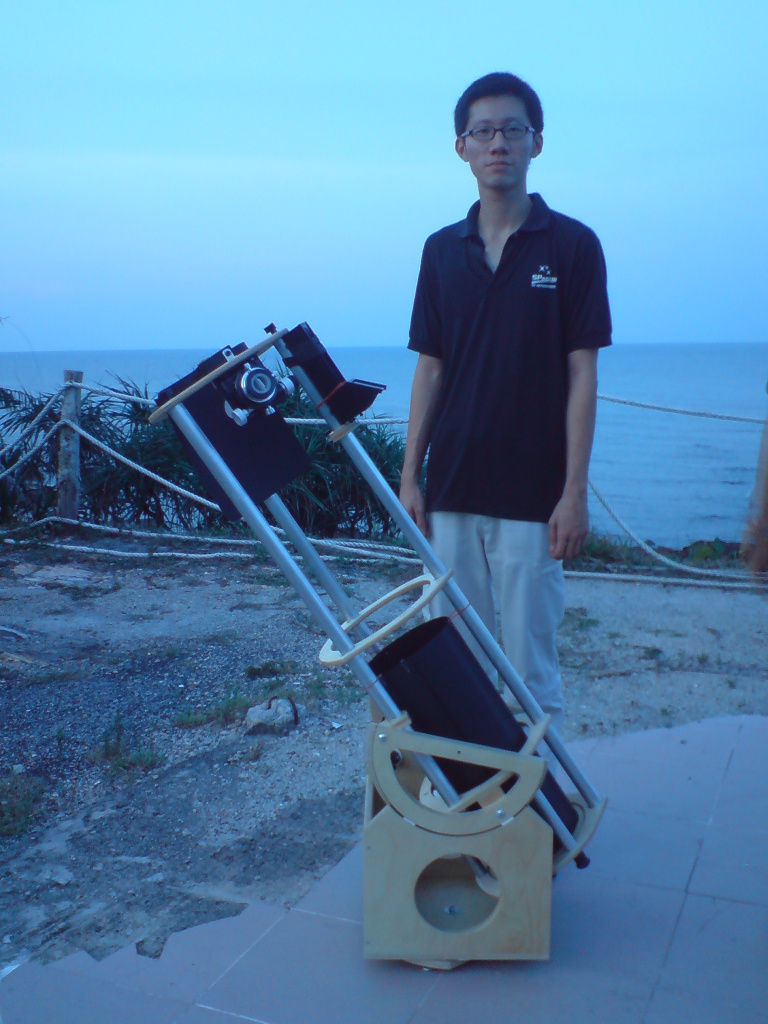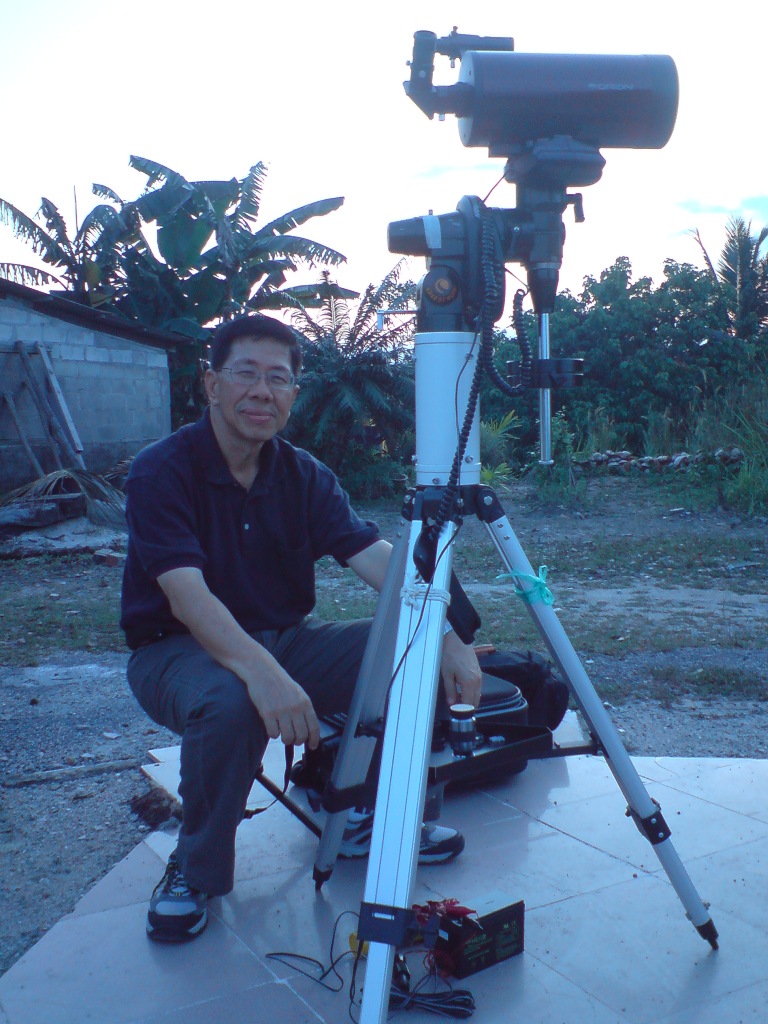Yesterday, Richard Low and his wife, Alfred from Ngee Ann Poly and i went up to Sedili Besar for some stargazing and first light too...
when we arrived at the nearby resort at around 4plus in the afternoon, the skies looked very promising. but after dinner around 6, it seems like a thin veil of clouds had moved in, so we went to the obs site with our fingers crossed to set up. btw, that place has very beautiful scenery.
Alfred brought a 5" Orion MCT on a CG-5 goto, Rlow had a Vixen 80mm Binoscope on a Hercules Altaz mount and me, my 8" f/6 dobstuff. both Rlow and my equipment were there for first light.
after setting up my scope and collimating it, i noticed a few things. the antares focuser had an inherent design that causes the focuser drawtube to
sag when racked out with eyepieces. it was apparent when we were collimating with the Howie Glatter laser. it is pretty minor until it was fully racked out. i just realised turning the focuser upside down might help, but that leaves my dual speed knob on the wrong side.
the 1.25" pentax XWs (Richard's) didnt have enough in-focus, so we pushed the primary out a couple of milimetres using the collimation bolts. then we lowered the scope to horizon to see how well it holds collimation... and there was a slight shift. it seems the problem is in the collimation interface design. the cell was pulled by wing nuts, but it was pushed by springs. when we loosened the wingnuts a few turns the spring had slacken enough to cause the one end of the mirror cell to "sink in" when tilted to horizon. the thickness of my mirror produced a greater moment on the collimation bolts and the small diameter of my mirror meant the collimation bolts were placed closer to the centre. pushing bolts to lock the mirror cell might be good while Rlow recommends making a sling.
there were balancing issues as well. the mirror box is just too light. i couldnt really determine where to optimally place the sliding counterweight to achieve good horizontal balance while reducing the size of the dobsonian hole. so we ended up having to use the altitude tensioning lock.
back to the skies. when night had fell, even with a 4-day moon, thin swaths of clouds across part of the sky, a lot of stars could still be seen. so we got down to observing.
one thing to note: i have short-sightedness 500 degrees and astigmatism 250 degrees on both eyes, coupled with a pair of rather aberrant spectacles,along with a short observing experience, so i cant give accurate comparison for optics and views.
first object was the most obvious (and unwanted) target: the Moon. with the XW20, the moon looks sharp and contrast seems good. i dont observe the moon often and havent observed it for quite so time i cant really compare the optics without a side-by-side comparison (to other scopes).
i wanted to see how well the optics are, so what fun is using 20mm? so i popped the XW5 in. the moon still looked sharp and contrast is still there. the only thing was the watery effect of either or both the atmosphere and boundary layer on the mirror.
next up was Omega Centauri. transparency was poor near that area and the moon was still there. while the core was resolvable at higher power, i didnt really notice much of a background glow from the cluster. M51 and M101 couldnt make it at that time either.
we also took a glimpse at saturn using the XW5. while saturn was low on the horizon and pretty much having no detail, the views still held up nicely and was still able to get a sharp focus on it. the bearings of the dob was smooth and tracking only took a bit of practice. the only issue was the altitude lock, making up-down adjustment slightly irritating.
when the moon was much lower, we started to look at some more deep sky objects. i couldnt really remember which order i saw them or how the exact environmental conditions were at the time, but dew started to set in early and secondary mirror had completely dew-ed up and i just continued to observe. my primary mirror had a makeshift dewshield extending nearly half the "tube", so i didnt bother to check if it had dew by the end of the session.
we also took a look at M4, M22 and M13. the views were similar. the core was resolved using the XW7 while preserving its background glow. with the 5mm, i couldnt detect any increase in detail but i lose out on the background glow.
open clusters M6 and M11 were wonderful. M7 wasnt as nice, it could fit into the XW20. we didnt try the XW40, its weight is just too insane.
transparency wasnt good for nebulae. M20 was pretty faint, although with averted vision, i could make out its edges and the dark lanes in the core. M8 was pretty boring. the 20mm might be too high, so i could only see the brighter regions of the nebula, so much so i though i wasnt looking at lagoon when i saw it. M17 is just M17... the head was a little hard to make out though. the nebulosity of M16 was quite faint as well. i had to use a averted vision to see it well, so i guess the "fingers" within was out of the question. on M27, the "apple core" was very bright and clear, but the edges didnt seem very well defined... might have been the dew too... the rest of the "apple" wasnt obvious either. Rlow says he could spot the central star, i still not sure if i did...
up next was veil nebula. i never knew i could see it with an 8" if not for Rlow pointing it out. cant remember which, but we used either a narrowband or a line filter to see the nebula. on the dimmest section of the veil, Rlow and richard didnt have any problem seeing it, but i took me quite a while to see it with averted vision. the brighter section were much easier to see though...
lastly was jupiter. while it was still quite low on the horizon, the views of it was still beautiful. using the XW5, there wasnt much contrast and detail but where there was, it was sharp and well defined. we could see GRS rotating out of view on 1 end while a shadow transit was coming into view on the other end. all of that despite a dew-ed up secondary.
our session ended around 1.30am as everyone had things to do the next day. overall, it was fruitful session. my observing experience isnt enough to gauge the optics but both Rlow and Alfred says my optics are good. i was pretty tired that night from not having proper sleep for a couple of nights before, so my memories of the session are a little hazy and my judgement might be impaired. Rlow and Alfred may be able to give a more accurate account of the session.
credits to this first light entirely goes to Rlow for inviting me for the observation session, lending me his accessories and eyepieces, and guiding me with his observing experience and astronomy knowledge. Thank you, Richard.
as for Rlow's binoscope, i havent looked through it much as i couldnt seem to achieve a sharp focus for both my eyes. so u will have to hear about it from him himself.
btw, i forgot to check my primary mirror for dew when i capped it up and it came home with small white patches all over it... and i never knew i was so hard to write an obs report.



